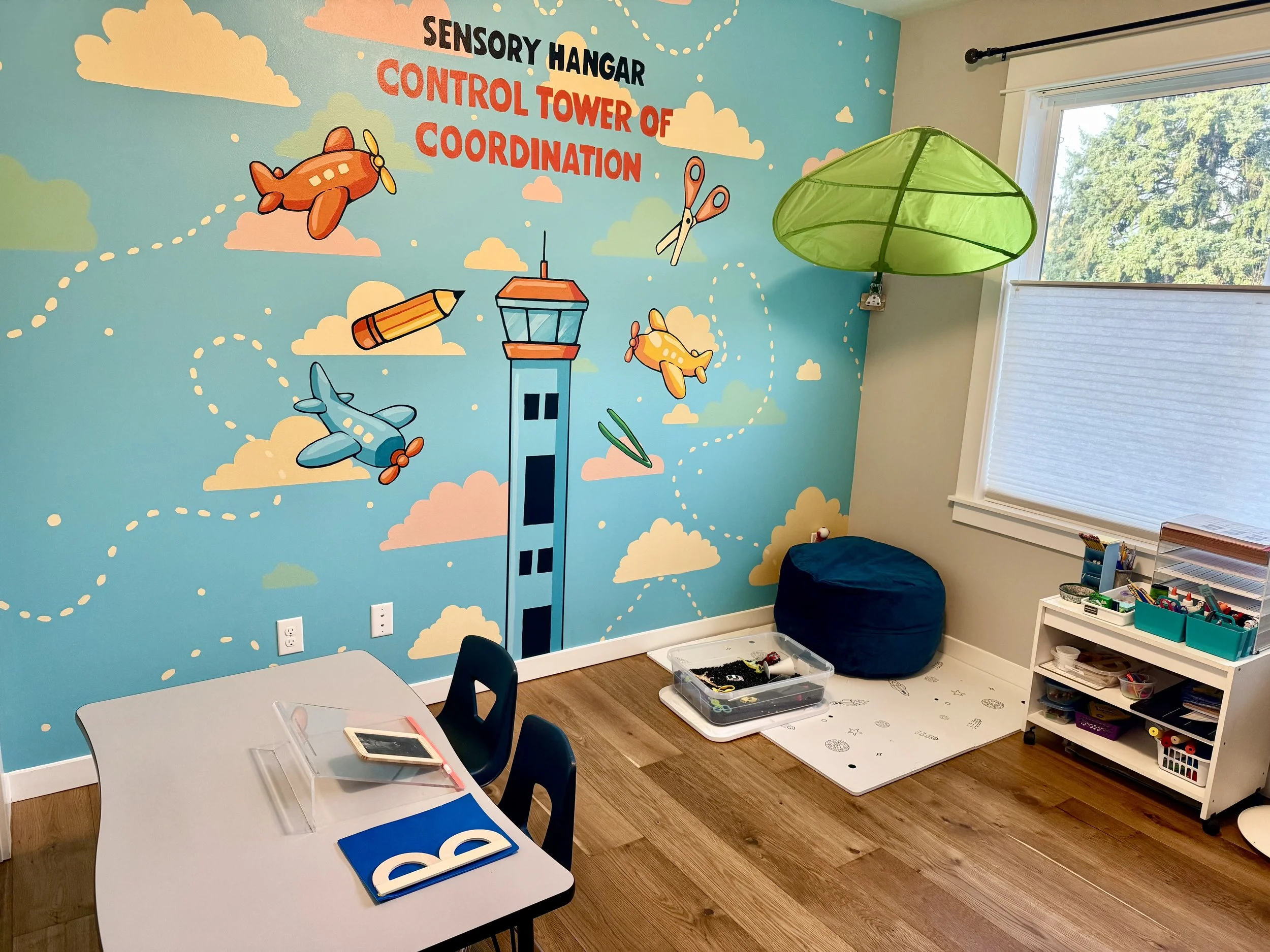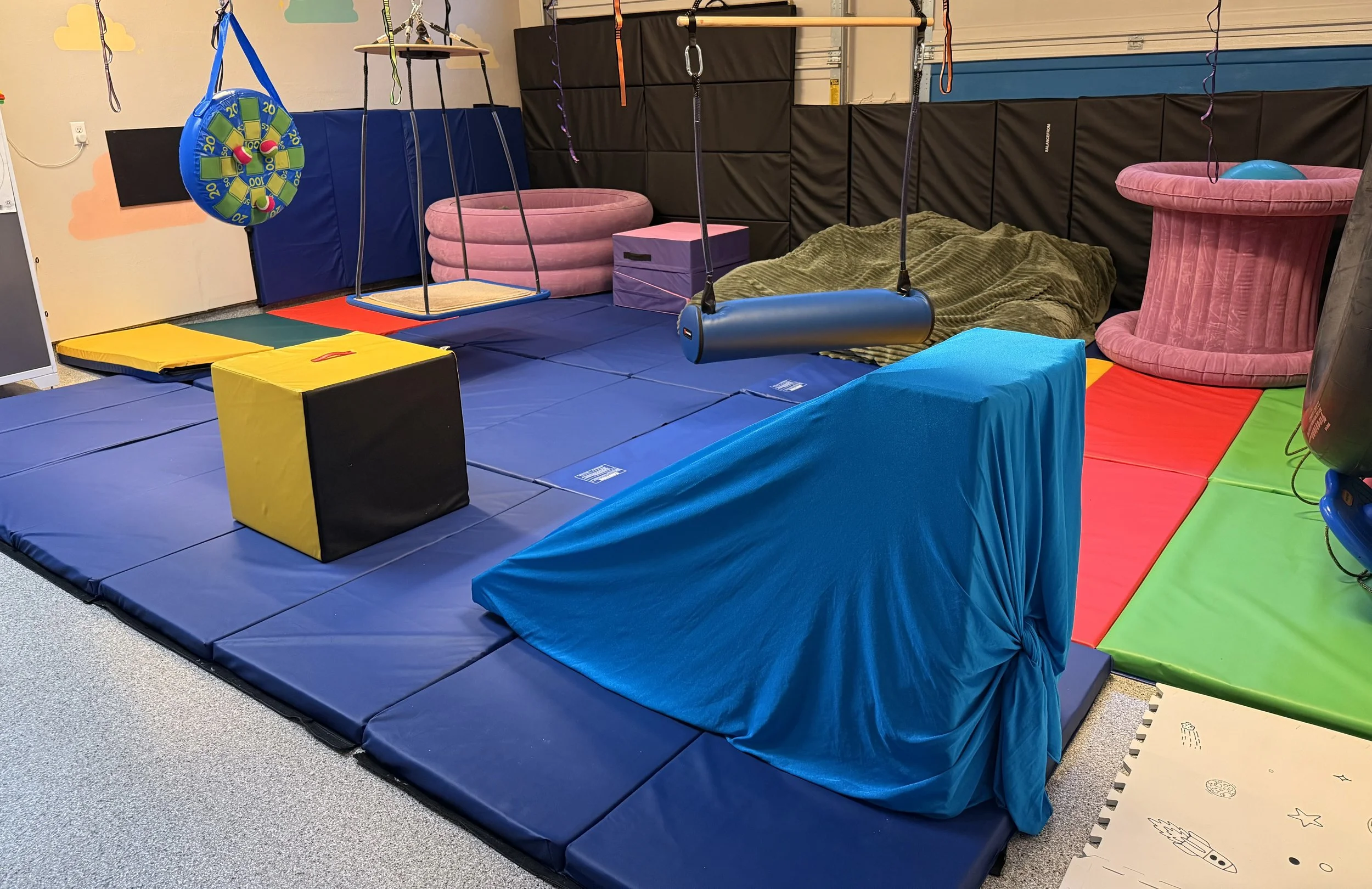Our occupational therapy treatment sessions at Sensory Hangar look a lot like play. Through therapeutic play children build the capacity to stay regulated, organize their bodies, generate ideas and plans, solve problems, build self-esteem and self confidence, and form meaningful relationships and connections. These foundation skills are essential for children to thrive both at home and in school. Playful interactions provide the ideal setting for developing motor skills, body awareness, purposeful actions and social success.
During play, your child’s occupational therapist is intentionally supporting arousal regulation, and motor skill development to help your child experience joy, success, and the “just right challenge”- meaning that therapy sessions are FUN and subtly structured so that your child is challenged but always successful. The emphasis is on developing an “adaptive response” to sensation in an active, meaningful, and fun way by interacting in a room filled with hanging equipment such as nets, ropes, swings and other climbing structures.
What is an adaptive response? An adaptive response is a successful, purposeful action that responds appropriately to environmental demands. It signifies that a person has successfully integrated sensory information from their environment and met a challenge, which in turn facilitates learning, development, and overall well-being. It results in outcomes like self-regulation, confidence and positive self-concept, motor skills, and improved attention. An example would be a child learning how to successfully ride a bicycle after falling off a few times.
Sensory integration therapy aims to enable children to accurately detect, regulate, and interpret sights, sounds, touch, body position, and movement. Improving how a child processes sensations from the world around them supports better focus, behavior, and motor planning skills-so daily activities that are important to them become easier and more enjoyable.
We gather information from these sensory systems
Proprioception (muscle and joint position)
Vestibular (head movement and the sense of motion and gravity)
Tactile (touch)
Olfactory (smell)
Gustatory (taste)
Visual (seeing)
Auditory (hearing)
Interoception (internal body feelings like hunger, pain, bowel & bladder function, temperature) - helps us understand how our physical needs affect our emotional states, such as when a fluttering stomach means we are anxious. Interoception is crucial for self-awareness, emotional regulation and overall well-being.
The way we perceive and organize sensory information from our sensory systems is the foundation for understanding ourselves and the world, and is a prerequisite for all academic learning.
Our aim at Sensory Hangar is to improve your child's self-esteem and confidence. We achieve this by thoughtfully tapping into the powerful intrinsic drive that every child possesses to explore, learn, and succeed. Crucially, our practice is anchored in a Neurodiversity-Affirming lens. This means we deeply respect and recognize that every client has a unique, valuable style of neurological processing that naturally leads to differences in how they sense, move, and operate within their environment. Rather than viewing behaviors as "desirable or undesirable" or seeking to "fix" the child, we strive to truly understand. This involves actively listening and observing the meaning and underlying communication behind a child's actions. Our interventions consistently prioritize the child's emotional well-being and positive, active engagement in the session over simple compliance. By fostering a strong therapeutic alliance and actively collaborating, we ensure that the goals we pursue are genuinely meaningful to both the child and the parents. This approach stands in contrast to imposing an agenda that disregards the client's lived experience. Finally, a significant element of our sessions is dedicated to teaching children self-advocacy and building their self-awareness regarding how their unique neurology positively and negatively shapes their daily experiences.
Sessions are always play based and primarily child led, meaning the therapist observes and follows the child’s lead, focusing on their interests and natural learning style. The goal of therapy is sensory stimulation in order to strengthen neural integration. The intrinsic drive of the child is very important, for it is the highest source of motivation that leads to responses of greater complexity and adaptivity in the nervous system. Self-directed motivation and active engagement, alone and with others, are essential drivers for the development of a secure self-concept and identity, and is instrumental for sustained learning throughout life.
“Organizing and evincing an adaptive response which is more mature and complex than any emitted before requires effort - the kind of effort that a child gladly summons when he is emotionally involved in the task and believes he can cope with it” (Dr. A Jean Ayers, Founder of Sensory Integration ).
Pediatric Occupational Therapy Sessions
OUR SPACE
A quiet space to play games, relax and do table-top activities
Our Sensory Gym aka “The Hangar”



